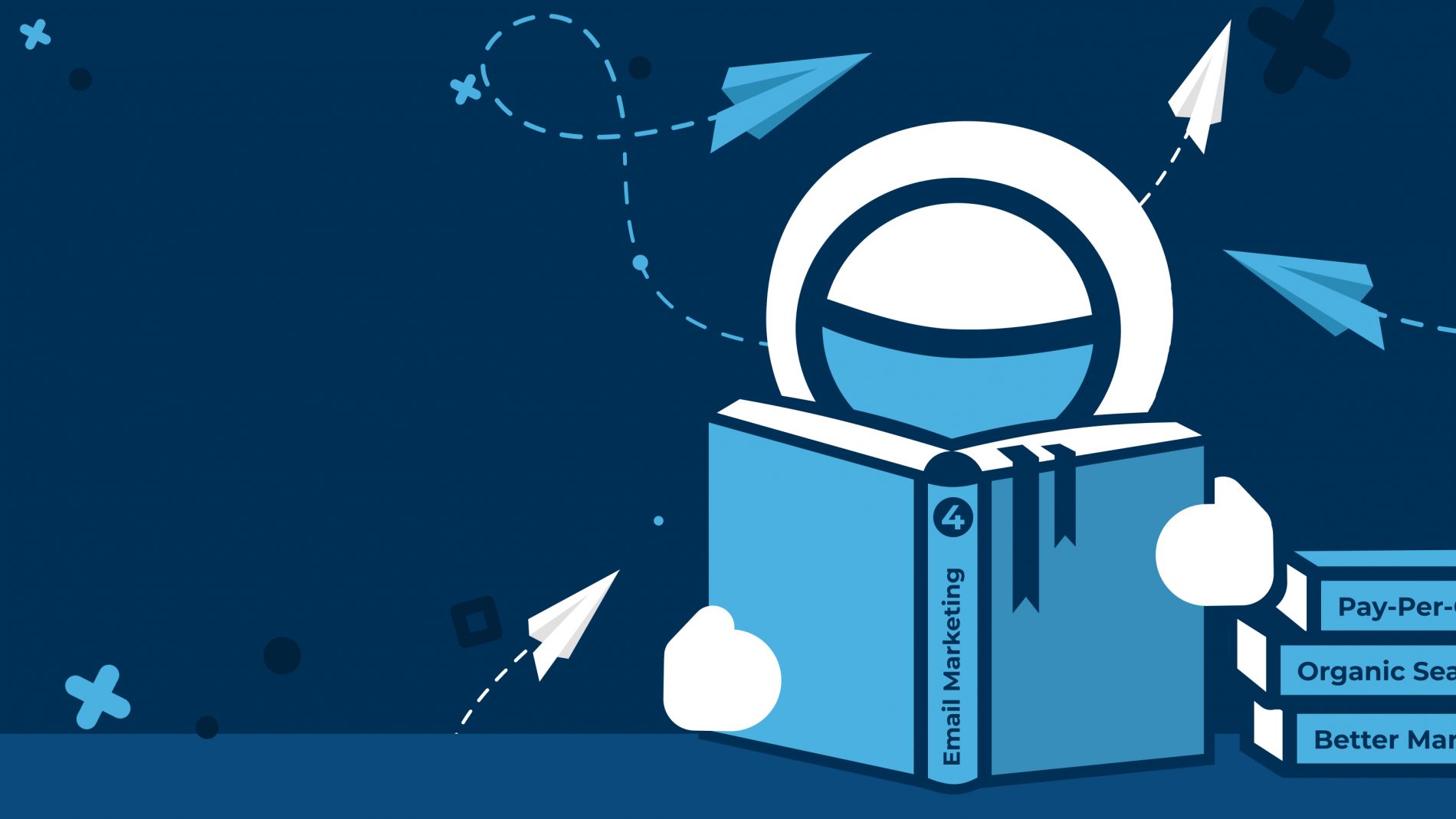
Guide to a Better Marketing Strategy, Part 4 — Email Marketing
Guide to a Better Marketing Strategy, Part 4 — Email Marketing
Moving along in our six-part guide to better marketing internet strategy, we’ll be looking at Email Marketing and how it’s an effective marketing channel for businesses of all sizes. Previously, we covered paid ad space on search engines with PPC, and the significance of organic search channels when it comes to optimizing your campaigns and content.
This time around, we’ll take a look at how best to use Email Marketing, things to avoid when sending out emails for business or marketing purposes, and what counts as email marketing compared to simple emails.
What is Email Marketing?
In the most general sense, email marketing is basically any email sent that helps a company generate more business. That’s a pretty broad definition. It covers things like email updates about sales and coupons, all the way to newsletters designed to keep an interested audience engaged in a business.
When it comes to using email as part of your ongoing marketing efforts, the definition narrows a bit. Emails in this context tend to be intentionally crafted with business generation in mind, and they often work in tandem with other marketing efforts to ensure an effective overall campaign. Basically, email does a lot. It helps with communication and marketing efforts, but more than anything else, email is about building relationships.
The most important function of good email marketing is to retain and generate repeat customers through regular contact. By developing a relationship with people that express interest in a business or products, email marketing increases the overall likelihood of those people converting to customers or clients.
Turning Email into Email Marketing
Email marketing is a bit of a strange marketing technique because it usually leans on or supports other, more concrete techniques. Communication in and of itself isn’t a sales technique, newsletters are useful and their intention may be to garner further interest, but they also not outright advertisements. Of course, emails are an excellent medium for other types of marketing outreach.
You can see how different types of emails present different types of opportunities for further marketing. In some cases, the content of the email itself isn’t necessarily as significant as where the email leads the reader, while in other cases the email content can serve as a call to action. Let’s take a look at the main forms of marketing email that appear throughout the industry:
- Transactional Emails
Transactional emails are generated as part of a transaction. It could be a monetary transaction or something like subscribing to a newsletter. If someone buys a product on Amazon, the digital receipt they get would be considered a transactional email.
Of course, a digital receipt isn’t exactly marketing by itself. Sticking with the Amazon example, consider the whole email. There’s the receipt that offers details about the exchange, and then there’s usually text, links, or pictures of products and services related to whatever was purchased. Those suggestions are what turn the email into a marketing tool.
- Announcement Emails
You’ll notice a trend when it comes to marketing emails. As the name suggests, announcement emails are basically just that. They announce things. New products? Upcoming sales? A business changing their location or updating the website? It’s all a good opportunity to stay in touch with a list of contacts that might be invested in whatever the email has to announce.
As a marketing technique, it’s straightforward. It’s an opportunity to outright tell people when something worth paying attention to is happening. Want more eyes on your holiday sale? Send out the details and a link to your page. Newsletters are also usually a form of recurring announcement email.
- Sales Emails
Once again, the name gives away the purpose. Sales emails are essentially direct sales offers in email form. They usually come in the form of coupons, sales, and deals. Imagine announcement emails, but with the narrower focus of sales based copy. Where announcements could cover basically any topic, including updates about company policies or participation in local events, sales emails are more direct.
Mix and Match
It’s worth noting that most of the time, these email styles will overlap. As we mentioned earlier, email marketing tends to work best when combined with other techniques like remarketing or the Amazon receipt example. Finding the best way to leverage these combinations is what Email Marketing is all about.
Remember, email is an incredibly reliable way to stay in touch with a variety of people in a business’ audience, and a good email marketing campaign will always be sending content to people that actually want to engage with the business. That’s why it’s important for essentially all businesses to maintain an up to date contact list.
Email Benefits: Tracking Value
As with all marketing efforts, measuring success is key. Recalling the very first post in this guide, putting an email marketing campaign in motion is useless if you’re not tracking and measuring all the data. It’s important to know which metrics matter, and how to determine whether or not those metrics look good or bad based on the particulars of your business.
Fortunately, the metrics for email marketing are all fairly simple to understand and track. The complexity of email marketing is developing content and getting to know how a target audience will react and engage with that content. The metrics you should be paying attention to are:
- Open Rate
- Click Rate
- Traffic To Website
- Conversions From Email
- Unsubscribe Rate
- Spam Rate
The metrics themselves are self-explanatory. Basically you want a high open and click rate, with a low unsub and spam rate. The more people that are opening and interacting with your emails, the better. If people are unsubscribing or reporting what you send out as spam, it might be time to reevaluate the strategy.
You should also measure traffic and conversions that result from an email. So, anytime someone comes to your website from a marketing email or any time you get new business as a result of successful email marketing, those are incredibly valuable data points to record and measure. Obviously you want these numbers to increase.
Whenever we’re running an email marketing campaign at Regex SEO, we’ll usually make use of an email marketing platform (something like SendGrid or MailChimp) to keep track of these numbers. Averages will vary by industry, but you should always be looking for something in these ranges:
(Image by Campaign Monitor)
On average, there’s a 2-4% variance when it comes to most of these metrics, and as you can see the average open and click-through rates are pretty close together across all industries. As the most significant metrics, these are the ones you’ll want to track more closely. Changes within that 2-4% range probably won’t affect the overall value of any campaign you’re running, but if that percentage starts to drop significantly below around 15% it may be time to reevaluate some aspect of your email plan. If you’re stuck and not sure what’s causing the drop in numbers, it might help to consult a marketing professional.
To Send, or Not To Send
Email is both incredibly simple and incredibly complicated. On one hand, all a business really needs to do is maintain contact and regularly provide value in each email. On the other hand, people deal with email so frequently and in such great volumes that it’s easy to forget some of the basics.
One example is forgetting that an audience might be composed of different demographics that value different things in each email. Maybe one group likes a regular newsletter, while another group signed up just for the deals. Sending everything to everyone is bound to negatively impact metrics because people will only interact with what interests them.
Let’s take a look at some of the dos and don’ts of email marketing
Don’t buy your contact list, Do grow your list organically.
If a list is bought, the people on that list won’t necessarily want the emails being sent. That will inevitably lead to a rise in unsub and spam rates, which is bad for marketing and could potentially lead to a penalty to your email sender reputation.
Sender reputation matters because a low reputation might get automatically flagged by email servers as spam or trash. With a low enough reputation, that can even lead to non marketing emails being marked as spam, effectively preventing the email address in question from being able to send anything.
Organic growth, on the other hand, is ideal. To start, any website or service should have a subscription option available. If people actually want to voluntarily sign up to receive marketing emails, you don’t want that process to be difficult at all. Good email marketing will have a way to add any interested parties to the contact list, usually through an easily accessible sign up option. The idea is that you want all of your email getting sent to people that actually want to read it.
Don’t send tons emails indiscriminately, Do use segmentation to meet demand.
Spam
Blasting out emails to everyone on your contact list is bad. To start, getting more than a certain number of emails from the same source every day will eventually annoy and push away an audience. You also have to consider whether or not the content being sent is relevant to every single person that gets the email.
Even with an organically compiled list of interested people, cultivating content that’s relevant to their interests is vital. The golden ratio for emails is something like “as many emails as you can send, without repeating yourself or running out of relevant information.”
If you find that you’ve bumped up against either of those factors, it’s probably a good time to revise your strategy or at least wait a while before sending out the next round of emails.
Segmentation
The best way to avoid spam, and to make email marketing more effective in general, is to use segmentation. Segmentation is the process of carving up the information you want to send out so that it makes a specific target group within the larger audience. Start by defining the groups: age, gender, purchasing habits, location, interests, and so on. Figure out what makes sense for the product or service in question, and divide your audience accordingly.
Dividing the audience increases the efficiency of email marketing. It circles back to metrics. The more relevant something is to a person’s interests, the more likely they are to engage favorably with the content sent. Higher open rates, and higher click through rates.
Writing content and designing emails for a massive audience is also generally a waste of time. Segmentation incentivizes creating more tailored and efficient emails targeted at smaller, more specific groups. It’s better for metrics, it’s better for the audience and builds a positive relationship, and it’s better for time and money spent creating the email content in the first place.
Perfecting the Process: Email Optimization
The last step in crafting a successful email marketing campaign is optimization. Optimizing is the process of testing and tweaking a process until it performs the way you want it to. In terms of email marketing, that means A/B testing the major facets of the actual emails being sent out. Things like design and subject line are good examples. Something as simple as changing the color of a CTA button in the email, or using a different emoji in the subject line can affect the open rate or click rate.
- Design
Optimizing the design of an email has two components. There’s creative design, and there’s technical design. In A/B testing, it’s important to pay attention to each aspect to determine how they’re influencing the performance of the email being tested. See if a color change increases click rate, make sure the images are loading fast enough for people to see them, things like that.
- Creative:Creative design is all about how an email looks and feels when you open it. It can cover anything from the colors on the page to the placement of text or images and interactive components. Taking the CTA as an example, changing the color or position on the page can make a pretty big difference in how likely people are to see it and click on it. That right there has a direct effect on click rate, and if the whole point of an email is to bring more subscribers or customers to a specific place, the links, buttons, and CTAs need to be easy to see and interact with.
- Technical:Technical design is more about the backend of the email. How fast does it open, how fast do images load. If someone clicks on the CTA or website link, how quickly does that link take a person to the website in question? While these might seem like small things that most people don’t notice, an email that takes too long to load might just as easily cause someone to skip following a vital link. Emails aren’t too different from web pages in that regard. You want them to load quickly and function without any interruption, or people will lose interest.
- Word Choice
Figuring out what kind of language to use is almost more of a content concern than an optimization concern. Still, subtle changes to the email’s introduction lines and key points like the CTA or other important blocks of information can influence how subscribers interact with the email.
A good example of putting A/B testing into practice with language is by trying out two different subject lines for an email. Take two subject lines, send it out to 500 people, and see which subject line results in a higher open rate. Repeat this process until you’re comfortable with the open rate, and then use the winning subject line for the actual piece of marketing.
- Timing and Sending Strategy
Testing and optimizing timing is a bit less straightforward than standard A/B testing, but it’s just as important. Technically, it’s possible to do the same kind of testing as with the subject line example, but audience and market research will help narrow things down by a noticeable amount.
Timing has more to do with email frequency. Essentially too much and it becomes spam, too little and people may not take notice when updates do finally come through. Finding the right rhythm, time of day, and frequency is a more involved process because it’s not as easy to test in batches. Basically, figuring this out comes down to experience in operating email marketing campaigns and paying attention to an email campaigns performance over an extended period of time.
Maximizing Email Marketing Campaigns
An email marketing campaign is much more than just staying in touch and reminding an active audience about the occasional sale. For the most effective campaign possible, it’s necessary to invest in rigorous testing and planning to ensure success. If you’re operating your own email marketing plan, the key points you’ll want to keep in mind are measuring metrics and handling your contacts list with care. And don’t forget to test everything along the way.
Digital marketing functions best as an ecosystem of cooperative techniques and campaigns coming together to support a business. While each channel has the potential to stand on its own, they really do work better together, and that holds true for email marketing. If you’re looking for guidance or a new email marketing campaign altogether, don’t be afraid to reach out to our team.

